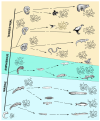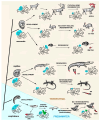Regeneration, Regengrow and Tissue Repair in Animals: Evolution Indicates That No Regeneration Occurs in Terrestrial Environments but Only Recovery Healing
- PMID: 39846631
- PMCID: PMC11755470
- DOI: 10.3390/jdb13010002
Regeneration, Regengrow and Tissue Repair in Animals: Evolution Indicates That No Regeneration Occurs in Terrestrial Environments but Only Recovery Healing
Abstract
The present, brief review paper summarizes previous studies on a new interpretation of the presence and absence of regeneration in invertebrates and vertebrates. Broad regeneration is considered exclusive of aquatic or amphibious animals with larval stages and metamorphosis, where also a patterning process is activated for whole-body regeneration or for epimorphosis. In contrast, terrestrial invertebrates and vertebrates can only repair injury or the loss of body parts through a variable "recovery healing" of tissues, regengrow or scarring. This loss of regeneration likely derives from the change in genomes during land adaptation, which included the elimination of larval stages and intense metamorphosis. The terrestrial conditions are incompatible with the formation of embryonic organs that are necessary for broad regeneration. In fact, no embryonic organ can survive desiccation, intense UV or ROS exposition on land, and rapid reparative processes without embryonic patterning, such as recovery healing and scarring, have replaced broad regeneration in terrestrial species. The loss of regeneration in land animals likely depends on the alteration of developmental gene pathways sustaining regeneration that occurred in progenitor marine animals. Terrestrial larval stages, like those present in insects among arthropods, only metamorphose using small body regions indicated as imaginal disks, a terrestrial adaptation, not from a large restructuring process like in aquatic-related animals. These invertebrates can reform body appendages only during molting, a process indicated as regengrow, not regeneration. Most amniotes only repair injuries through scarring or a variable recovery healing, occasionally through regengrow, the contemporaneous healing in conjunction with somatic growth, forming sometimes new heteromorphic organs.
Keywords: development; evolution; healing; metazoans; regeneration.
Conflict of interest statement
The author declares no conflict of interest.
Figures





References
-
- Goss R. Principles of Regeneration. Academic Press; New York, NY, USA: 1969.
LinkOut - more resources
Full Text Sources

